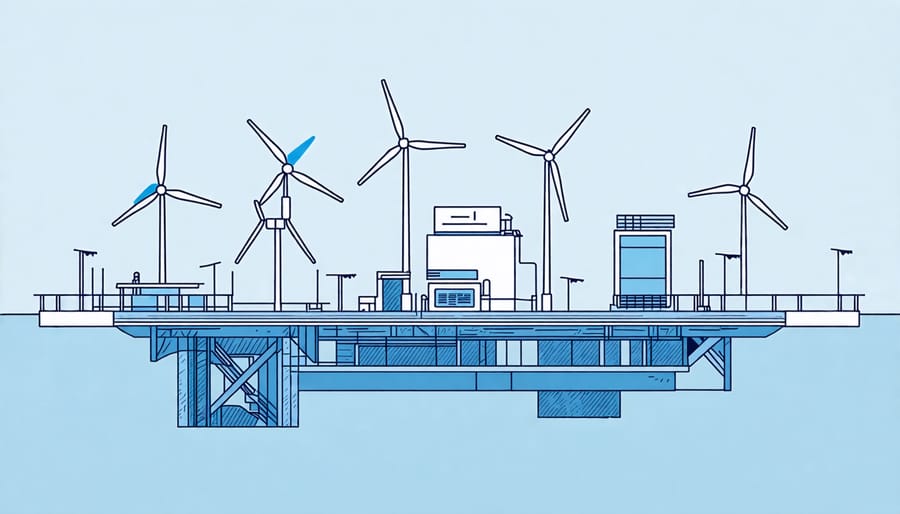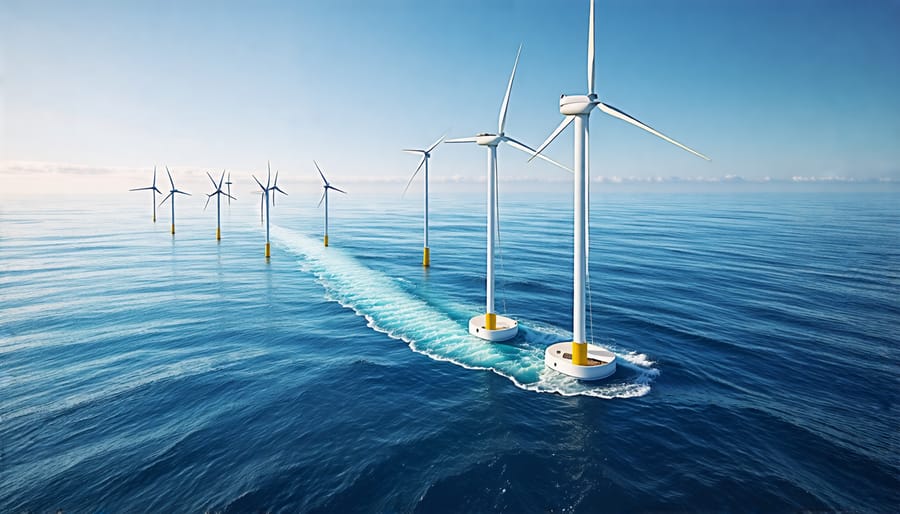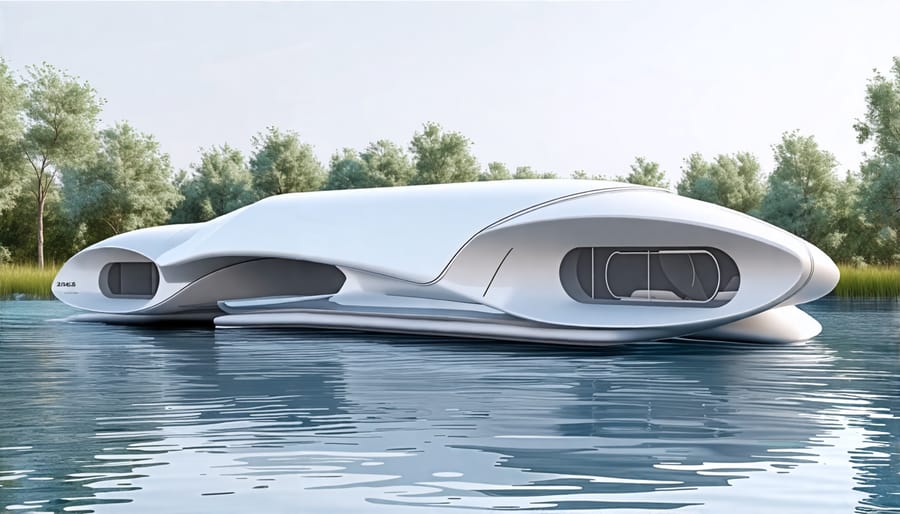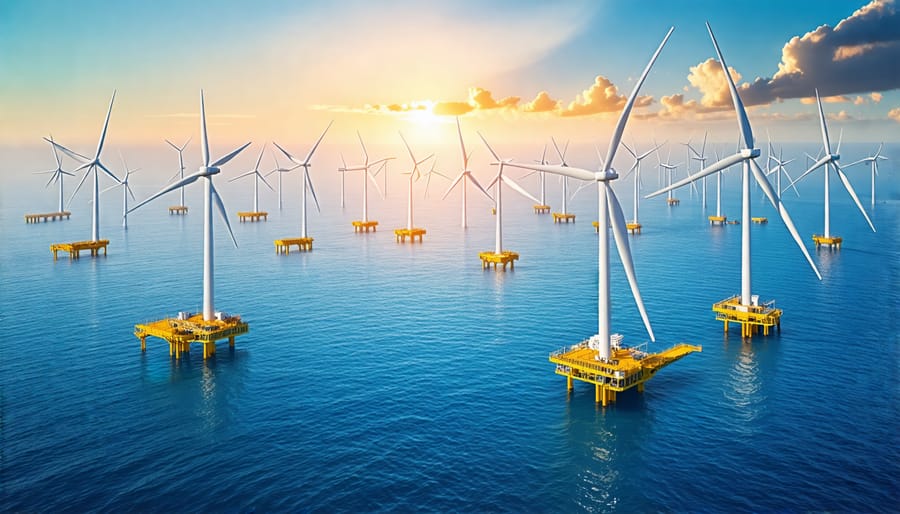Explore the revolutionary potential of Windfloat by first understanding its floating offshore wind technology. Leverage this innovation to harness wind energy in deep waters where traditional turbines falter. Recognize how its unique three-column semi-submersible platform design offers stability even in turbulent conditions, optimizing energy efficiency. Integrate this knowledge into environmental policies to promote sustainable energy options and minimize carbon footprints. Engage with real-life case studies showcasing successful Windfloat deployments to inspire similar initiatives globally, enhancing the dialogue on renewable energy advancements.
The Mechanism of Windfloat

Components of a Windfloat Structure
Windfloat technology stands as a remarkable advancement in harnessing renewable energy from offshore winds. At its core, the Windfloat structure consists of three key components: the floating platform, the mooring system, and the wind turbine. The floating platform is a semi-submersible structure designed to maintain stability even in the harshest marine conditions. Its innovative design minimizes wave-induced motion, allowing for efficient energy capture in deeper waters where traditional fixed foundations are impractical.
The mooring system, comprising of several mooring lines connected to anchors on the seabed, ensures that the Windfloat remains securely in place while allowing some degree of movement to accommodate ocean swells. This flexibility enhances the durability and lifespan of the installation. Atop the floating platform, the wind turbine converts kinetic wind energy into electricity. This turbine is typically a powerful, multi-megawatt unit optimized for offshore environments, capturing high-velocity winds more efficiently.
Together, these components enable Windfloat technology to access untapped wind resources far from shore, offering a sustainable and scalable solution to meet growing energy demands with minimal environmental impact.
How Windfloat Harnesses Offshore Wind
Windfloat revolutionizes the way we capture energy from offshore winds, providing a sustainable and efficient solution for renewable energy enthusiasts and policymakers alike. At its heart, Windfloat utilizes cutting-edge floating platform technology to anchor wind turbines to the ocean, where winds are often stronger and more consistent than on land. This innovative system allows turbines to operate in depths of up to 1,000 meters, vastly expanding the potential locations for offshore wind farms.
The process begins as the strong ocean winds turn the blades of the turbine. The kinetic energy generated by these rotations is then converted into electricity through a generator located at the top of the turbine. The floating foundation, which resembles a buoyant tripod, ensures stability, even in harsh marine environments. This ability to remain steady amidst the ocean’s swells is integral to harnessing consistent energy output, minimizing downtime caused by maintenance issues. To understand the intricate details of this technology, exploring the overall wind power function can provide additional insights into how Windfloat optimizes these natural forces.
Real-life deployments of Windfloat technology have already showcased its potential and optimism for a sustainable future, with successful implementations in locations like Portugal’s Atlantic shores, where renewable energy is not just an ideal but an active reality.
Environmental Benefits of Windfloat
Reducing Carbon Footprint
Windfloat technology represents a significant step toward reducing carbon footprints globally. By enabling the use of wind energy offshore, where winds are more consistent and stronger, Windfloat allows for a greater generation of renewable energy compared to traditional land-based turbines. This cutting-edge technology ensures minimal interference with marine ecosystems, making it an environmentally friendly option for harnessing clean energy. In real-life applications, Windfloat systems have demonstrated their potential to drastically reduce reliance on fossil fuels, thus lowering greenhouse gas emissions. Interviews with experts in the field underscore how Windfloat’s innovative design facilitates deeper water installations, offering a viable solution for countries seeking to meet aggressive carbon reduction targets. Embracing these advanced systems is a positive stride towards a greener, more sustainable future.
Marine Life Conservation
Offshore wind farms, like those employing Windfloat technology, play a crucial role in generating clean energy while emphasizing marine life conservation. Recognizing the potential impacts on marine ecosystems, efforts are continuously being made to minimize disturbance to underwater habitats. Projects such as these often involve comprehensive environmental assessments to understand local biodiversity and the potential implications of installations. By collaborating with marine biologists and engaging in active monitoring, each Windfloat site is tailored to mitigate disruption. Case studies have shown that with careful planning, Windfloat platforms can coexist with marine life, sometimes even enhancing local ecosystems by serving as artificial reefs. The incorporation of quieter technology and floating structures that avoid seabed anchoring further illustrates the industry’s commitment to safeguarding the oceans. These initiatives reflect an optimistic intersection of innovation and environmental stewardship.
Real-Life Case Studies
Windfloat Atlantic Project
The Windfloat Atlantic Project stands as a pioneering initiative in the realm of innovative offshore wind projects. Situated off the coast of Portugal, this project harnesses the power of floating wind turbine technology to generate clean energy, setting a benchmark for sustainable solutions. The Windfloat Atlantic boasts three floating platforms, each supporting a colossal turbine, enabling them to operate in deeper waters where traditional fixed-foundation turbines cannot reach. This not only expands the potential for wind energy generation but also minimizes the environmental and visual impact associated with energy projects close to shorelines.
The outcomes of the Windfloat Atlantic Project have been notably optimistic, showcasing that floating wind technology can be scaled effectively and economically. By leveraging advanced engineering and design, the turbines have demonstrated consistent energy production even amid challenging sea conditions. This success paves the way for further innovations in floating wind solutions globally, contributing significantly to the reduction of carbon emissions and promoting the widespread adoption of renewable energy sources. The Windfloat Atlantic stands as an inspiring model for others aiming to harness the vast potential of offshore wind energy.


Future Prospects and Innovations
Looking to the horizon, the Windfloat technology is poised for exciting advancements and expansion, driving the future of renewable energy. As offshore wind power garners greater attention for its environmental benefits and vast potential, Windfloat, with its floating platform design, stands ready to lead innovation. Current projects are exploring new depths, literally and figuratively, as Windfloat’s flexible technology allows for the installation of turbines in deep waters where winds are stronger and more consistent. This not only increases energy output but also minimizes visual and ecological impacts close to shore.
One of the most promising prospects is the integration of larger, more efficient turbines on these floating platforms, potentially doubling current energy outputs. Collaborations with energy firms and research institutions aim to refine these advancements, underlining Windfloat’s role in overcoming logistical challenges related to installation and maintenance in challenging offshore environments. As more countries commit to ambitious renewable energy targets, Windfloat is positioned to be a vital player in the transition towards sustainable, clean energy solutions.
Challenges and Solutions
Technical Challenges
Windfloat technology, while promising for sustainable energy, faces several technical challenges that require innovative solutions. One primary challenge is stability; floating wind turbines must endure harsh marine conditions, including strong winds and waves. To address this, engineers designed Windfloat with a semi-submersible platform using water ballast and mooring systems for stability. Another issue is the installation and maintenance of these structures in deep waters, necessitating specialized vessels and equipment. Overcoming grid connectivity hurdles is also crucial, as offshore wind farms need reliable transmission to land-based grids. Innovations in dynamic cabling and floating substations are pivotal in tackling this. Achieving cost-effectiveness remains a goal, with research focused on scalable manufacturing processes and materials like lightweight composites. Despite these challenges, Windfloat continues to drive advancements in offshore renewable energy.
Economic Considerations
Windfloat technology is revolutionizing offshore wind energy by offering economic advantages that are difficult to ignore. Unlike traditional wind turbines, which require extensive infrastructure, Windfloat platforms are designed to float, significantly reducing installation and maintenance costs. This flexibility allows for deployment in deeper waters with stronger, more consistent winds, thus maximizing energy generation. The scalable nature of Windfloat technology means that initial investments can be recuperated more quickly through increased energy output and reduced operational expenses. Real-life examples demonstrate how countries like Portugal are successfully harnessing these economic benefits. For instance, the Windfloat Atlantic project has not only boosted local economies through job creation but also shown potential for cost reductions in renewable energy at a global scale. As such, Windfloat represents a promising economic opportunity for sustainable energy policy makers and investors alike.
Interview with an Industry Expert
I recently had the opportunity to speak with Dr. Emily Lawson, a renowned expert in offshore wind energy, on the innovative Windfloat technology. Dr. Lawson emphasized the transformative potential of floating wind turbines, stating, “Windfloat opens up possibilities for harnessing wind power in deeper waters where traditional turbines can’t reach.” She elaborated on the advantages, noting that these platforms minimize the impact on marine life and coastal landscapes. “They offer a more environmentally friendly solution that aligns with sustainable energy goals,” she added.
Dr. Lawson shared a fascinating case study from Portugal, where Windfloat is already making waves. “The Windfloat Atlantic project has shown substantial energy output with minimal ecological disruption, proving this technology’s feasibility on a larger scale,” she explained. Her insights into the future of offshore wind energy remain optimistic, highlighting Windfloat’s potential to revolutionize renewable energy solutions worldwide. As policymakers and companies strive for sustainable practices, the enthusiasm and expertise of leaders like Dr. Lawson hint at a promising wind-driven future.
Conclusion
Windfloat has reshaped the renewable energy landscape by introducing floating offshore wind technology that opens new possibilities for sustainable power generation. Its ability to harness wind energy in deeper waters, previously inaccessible with traditional fixed turbines, promises significant environmental benefits by reducing reliance on fossil fuels and tapping into abundant offshore wind resources. As demonstrated in real-life implementations, Windfloat’s innovative design has proven its efficiency and adaptability, offering a compelling solution for clean energy enthusiasts and policy-makers alike. With optimism towards a greener future, Windfloat stands at the forefront of the transition towards more sustainable and resilient energy systems.





